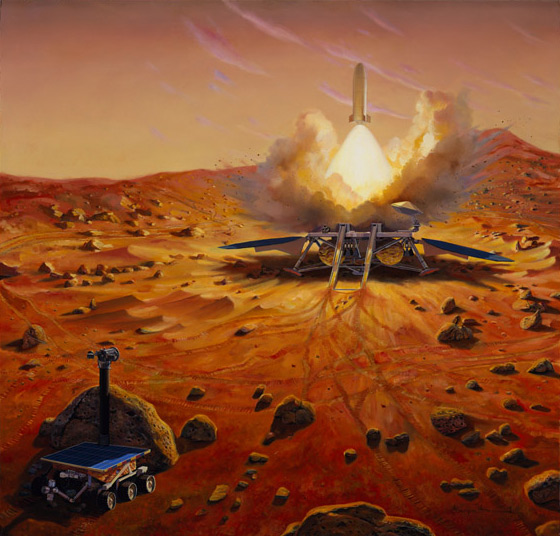Report: How to Get Samples from Mars

GOLDEN, Colorado – It is considered by many engineers and scientists as the "Holy Grail" of robotic red planet exploration: a Mars Return Sample mission.
A newly issued working group report by the International Mars Architecture for the Return of Mars Samples (iMARS) provides a fresh, new look at how to undertake such a project. NASA and European Space Agency (ESA) planners took part in shaping the report, working with an international confab of experts.
The Phase 1 summary report was carried out between September 2007 and May 2008.
The report has an array of findings, such as noting that a Mars Sample Return (MSR) effort could be divided into approximately 20 separate elements that could be considered for funding by different international entities.
If the resources are available -- and decision-dealing and political spheres of influence are in alignment -- the report says that the MSR mission could be started in roughly 2013 -- leading to launches of MSR hardware around 2020, with the samples back here on Mother Earth some three years later.
Lots of mission options were looked at but they center on using two individual launches.
Spotlighted in the report is use of an Atlas A 551 booster to toss to Mars a lander equipped with the hardware to snag, bag, and shoot into Mars orbit select samples. An Ariane 5 EC rocket would be utilized to propel a snappy Mars orbiter that catches and stuffs the martian goodies inside the orbiter for a return trek to Earth.
Get the Space.com Newsletter
Breaking space news, the latest updates on rocket launches, skywatching events and more!
Report conclusions
The primary conclusions of the iMARS analysis include:
- In order for MSR to be broadly acceptable to the international scientific community, it would need to be able to return carefully selected, diverse samples from Mars. It would need to return these samples in a controlled way to maintain the sample's scientific integrity. These considerations have significant implications for the design and operations of the end-to-end Mars sample return mission including both the flight and ground systems.
- Between the flight elements, ground systems, and scientific analysis, iMARS identified approximately 20 primary building blocks that could be led or supported by different international participants.
- Five high-priority mission design options have been identified, all of which would make use of the launch opportunities from 2018–2022. All options would involve two launches and at least one Sample Receiving Facility (SRF) certified prior to return of the sample.
- The development timeline for MSR has two long-lead aspects that must be planned for: New technology development for the flight elements and the SRF(s), and site selection for the latter. In both cases, substantive effort must begin at least 10 years before launch of the flight segment.
- Public outreach and communication require particular attention due to the nature of this mission and need to be addressed in an open and well-managed way from the very beginning.
International institute
The current consensus for the end-to-end MSR mission costs range from $4.5 billion to $8 billion – so in financial speak, the project is a top-dollar, high-end affair.
"The iMARS architecture and plans provide a path towards a fully international, affordable MSR mission," the study concludes.
As a next step -- among many highlighted in the iMARS report -- is the possibility of forming an International MSR Science Institute (IMSI). This is envisioned to be a virtual institute, a confederation of Mars science agencies or countries that are substantially involved in MSR, from missions to sample analysis to curation.
- Gallery: Ice on Mars
- How Sample Return Might Find Life on Mars
- Video: Life Search for Life on Mars
Join our Space Forums to keep talking space on the latest missions, night sky and more! And if you have a news tip, correction or comment, let us know at: community@space.com.

Leonard David is an award-winning space journalist who has been reporting on space activities for more than 50 years. Currently writing as Space.com's Space Insider Columnist among his other projects, Leonard has authored numerous books on space exploration, Mars missions and more, with his latest being "Moon Rush: The New Space Race" published in 2019 by National Geographic. He also wrote "Mars: Our Future on the Red Planet" released in 2016 by National Geographic. Leonard has served as a correspondent for SpaceNews, Scientific American and Aerospace America for the AIAA. He has received many awards, including the first Ordway Award for Sustained Excellence in Spaceflight History in 2015 at the AAS Wernher von Braun Memorial Symposium. You can find out Leonard's latest project at his website and on Twitter.









